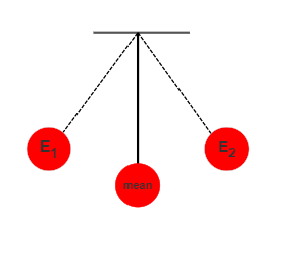
The average kinetic energy of a simple harmonic oscillator is \[2J\] and its total energy is\[5J\]. Its minimum potential energy is:
A. \[1J\]
B. \[1.5J\]
C.\[2J\]
D. \[3J\]
Answer
219.6k+ views
Hint: Before we proceed with the problem, it is necessary to know the simple harmonic oscillator. A simple harmonic oscillator is a system that is composed of a mass\[m\]. When a force \[F\] is applied to the mass, it starts to oscillate between mean positions and extreme positions.
Complete step by step solution:
In an oscillator, there are two extreme positions at \[{E_1}\]and\[{E_2}\]. The mass oscillates between these two positions. Therefore, an oscillator has,
A. Maximum K.E. and minimum P.E. at the mean position.
B. Minimum K.E. and maximum P.E. at the extreme position.
We know that total energy is equivalent to the sum of K.E. and P.E.

Image: Simple pendulum
Here it given that total energy \[ = 5J\]
Average kinetic energy \[\langle KE\rangle = 2J\]
We know that average kinetic energy is calculated by the formula,
\[\langle KE\rangle = \dfrac{{K{E_{\max }} + K{E_{\min }}}}{2}\]
\[\begin{array}{l}2 = \dfrac{{K{E_{\max }} + 0}}{2}\\ \Rightarrow K{E_{\max }} = 4\end{array}\]
When the potential energy is minimum then kinetic energy is maximum. Therefore total energy can be written as
\[TE = K{E_{\max }} + P{E_{\min }}\]
\[\Rightarrow 5 = 4 + P{E_{\min }}\]
\[\Rightarrow P{E_{\min }} = 5 - 4 = 1J\]
\[\therefore P{E_{\min }} = 1J\]
Hence, option \[A\] is correct.
Note: In the concept of the simple harmonic oscillator, students are often confused between the energies at the mean position and at the extreme position. At the mean position, the mass \[m\] is at rest i.e., \[x = 0\], so P.E. is zero and K.E. is maximum. At the extreme position, the mass \[m\] is at maximum distance from the mean position. So their P.E. is maximum while K.E. is zero.
Complete step by step solution:
In an oscillator, there are two extreme positions at \[{E_1}\]and\[{E_2}\]. The mass oscillates between these two positions. Therefore, an oscillator has,
A. Maximum K.E. and minimum P.E. at the mean position.
B. Minimum K.E. and maximum P.E. at the extreme position.
We know that total energy is equivalent to the sum of K.E. and P.E.

Image: Simple pendulum
Here it given that total energy \[ = 5J\]
Average kinetic energy \[\langle KE\rangle = 2J\]
We know that average kinetic energy is calculated by the formula,
\[\langle KE\rangle = \dfrac{{K{E_{\max }} + K{E_{\min }}}}{2}\]
\[\begin{array}{l}2 = \dfrac{{K{E_{\max }} + 0}}{2}\\ \Rightarrow K{E_{\max }} = 4\end{array}\]
When the potential energy is minimum then kinetic energy is maximum. Therefore total energy can be written as
\[TE = K{E_{\max }} + P{E_{\min }}\]
\[\Rightarrow 5 = 4 + P{E_{\min }}\]
\[\Rightarrow P{E_{\min }} = 5 - 4 = 1J\]
\[\therefore P{E_{\min }} = 1J\]
Hence, option \[A\] is correct.
Note: In the concept of the simple harmonic oscillator, students are often confused between the energies at the mean position and at the extreme position. At the mean position, the mass \[m\] is at rest i.e., \[x = 0\], so P.E. is zero and K.E. is maximum. At the extreme position, the mass \[m\] is at maximum distance from the mean position. So their P.E. is maximum while K.E. is zero.
Recently Updated Pages
Electricity and Magnetism Explained: Key Concepts & Applications

JEE Energetics Important Concepts and Tips for Exam Preparation

JEE Isolation, Preparation and Properties of Non-metals Important Concepts and Tips for Exam Preparation

JEE Main 2021 July 25 Shift 1 Question Paper with Answer Key

JEE Main 2021 July 22 Shift 2 Question Paper with Answer Key

States of Matter Chapter For JEE Main Chemistry

Trending doubts
Understanding Uniform Acceleration in Physics

Understanding Atomic Structure for Beginners

Understanding Centrifugal Force in Physics

JEE Main Marking Scheme 2026- Paper-Wise Marks Distribution and Negative Marking Details

Degree of Dissociation: Meaning, Formula, Calculation & Uses

Understanding Average and RMS Value in Electrical Circuits

Other Pages
NCERT Solutions for Class 11 Physics Chapter 6 System Of Particles And Rotational Motion 2025-26

Understanding Entropy Changes in Different Processes

Common Ion Effect: Concept, Applications, and Problem-Solving

Understanding Excess Pressure Inside a Liquid Drop

NCERT Solutions For Class 11 Physics Chapter 12 Kinetic Theory - 2025-26

Motion In A Plane Class 11 Physics Chapter 3 CBSE Notes - 2025-26




